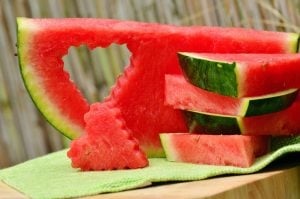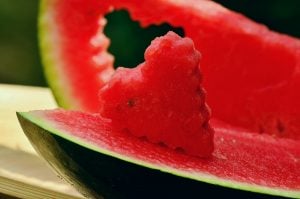 Summer, hot, sunshine … Do you want something juicy, refreshing and healthy? Reach for a decent piece of chilled watermelon! This wonderful fruit is not only a great way to hydrate the body (it contains up to 92% of water), but also brings many health benefits! It reduces fat accumulation, improves muscle functionality and reduces pain, prevents heart disease, has anti-inflammatory effects, is a powerful antioxidant, and it improves the appearance of your skin. Do you want to learn more? I invite you to read on!
Summer, hot, sunshine … Do you want something juicy, refreshing and healthy? Reach for a decent piece of chilled watermelon! This wonderful fruit is not only a great way to hydrate the body (it contains up to 92% of water), but also brings many health benefits! It reduces fat accumulation, improves muscle functionality and reduces pain, prevents heart disease, has anti-inflammatory effects, is a powerful antioxidant, and it improves the appearance of your skin. Do you want to learn more? I invite you to read on!
Watermelon with tomatoes is at the forefront of food products that are the focus of scientists studying lycopene and its effects on the human body. Lycopene is a carotene, a dye naturally found in plants, which is particularly important for the health of our circulatory system, as well as for maintaining the correct bone condition. Most of the red fruit owes its colour to anthocyanins. Watermelon, on the other hand, owes its characteristic colour thanks to lycopene. Red grapefruit and guava also contain significant amounts of this carotene. Lycopene has a strong anti-inflammatory effect by inhibiting the production of molecules signaling inflammation. Activation of enzymes involved in reactions starting inflammation is also reduced. In addition, lycopene has the neutralisation properties of reactive oxygen compounds.
Cucurbitacin E is another unique compound contained in the watermelon. It is a phytomateride with anti-inflammatory activity. However, unlike most antioxidants, Cucurbitacin E does not neutralise reactive oxygen compounds. Cucurbitacin E fights reactive nitrogen compounds. Watermelon slows down the aging process. In addition, a large dose of vitamins A perfectly moisturises the skin, improving its condition and appearance, and the amount of vitamin C ensures the maintenance of the correct structure of collagen, meaning firm and tense skin.
 Researchers are beginning to research more and more about the citrulline contained in the watermelon. A glass of watermelon pieces provides as much as 250 mg citrulline. Interestingly, citrulline took its name from the Latin word citrullus, which means watermelon. Citrulline is an amino acid that is easily converted into arginine in our kidneys. Then arginine positively affects the blood circulation in the body and has many beneficial effects preventing the development of heart disease.
Researchers are beginning to research more and more about the citrulline contained in the watermelon. A glass of watermelon pieces provides as much as 250 mg citrulline. Interestingly, citrulline took its name from the Latin word citrullus, which means watermelon. Citrulline is an amino acid that is easily converted into arginine in our kidneys. Then arginine positively affects the blood circulation in the body and has many beneficial effects preventing the development of heart disease.
This is due to the functioning of an enzyme called nitric oxide synthase (NOS), which is present, for example, in muscle cells of the blood vessels. The effect of NOS is the relaxation of smooth muscles, increased diameter of veins and arteries, and thus a greater blood supply to organs and a reduction in blood pressure. Unfortunately, just eating a watermelon is not able to significantly change the blood pressure in humans.
The actual effects can be seen only at very high consumption: 3 – 6 glasses a day of freshly squeezed watermelon juice for at least 3 weeks. Watermelon, on the other hand, benefits people who are deficient in arginine or reduced conversion of citrulline to arginine.
The improvement of circulation, which is due to arginine and indirectly citrulline, is of great importance for athletes and people who train recreationally. A good supply of blood to muscles means more oxygen and glucose, and therefore effective work. In addition, the removal of harmful waste products is also more effective. So what do we get thanks to the watermelon? Good training and reduced post-workout muscular pain!
Another very interesting information: recent studies show that the increased conversion of citrulline to arginine contributes to the reduction of fat accumulation by blocking a certain enzyme (TNAP), which plays a role in the metabolism and absorption of fatty acids in the intestinal villi. In addition, TNAP also acts on fat cells which, as a result of increased amounts of arginine, tend to absorb less fatty acids. Researchers are very positive about the idea that eating watermelon, and thus providing a large amount of citruline in food, can contribute to the prevention of overweight and obesity.
 When talking about watermelons, it’s hard not to mention the seeds. Well, it is worth eating watermelon with seeds. These small black seeds contain small amounts of iron and zinc. However, everyone knows that watermelon has a lot of seeds in it, so the amount of iron and zinc becomes significant. What’s more, research shows that these minerals obtained from watermelon seeds are extremely well absorbed (85 – 90%). In addition, the seeds also provide us with valuable protein and fiber.
When talking about watermelons, it’s hard not to mention the seeds. Well, it is worth eating watermelon with seeds. These small black seeds contain small amounts of iron and zinc. However, everyone knows that watermelon has a lot of seeds in it, so the amount of iron and zinc becomes significant. What’s more, research shows that these minerals obtained from watermelon seeds are extremely well absorbed (85 – 90%). In addition, the seeds also provide us with valuable protein and fiber.
Recently, an interesting study comparing the content of minerals, vitamins and antioxidants in various parts of watermelon was published. The fruit was distinguished in the middle, the end close to the stem, the blooming end and the edges themselves, close to the skin. The results showed a huge mineral richness of watermelon in all parts of the fruit. This means that no matter if you like a juicy center or you love to bite a watermelon to the skin, you always get health benefits from this red fruit.
However, it is important to eat a ripe red watermelon. It turns out that the white-pink watermelon, which is just ripening, practically does not contain any lycopene at all. A big jump in the concentration of lycopene occurs when the watermelon becomes pink, however the redder the colour is, the greater health benefits for you.
To realise the difference: 100g of a red watermelon contains 600 μg of β-cathoren and 6500 μg of lycopene, whereas a watermelon of a colour similar to white has only 5-10 μg of β-carotene and the amount of lycopene too small to measure… Another good fact: even sliced watermelon can be stored in the refrigerator for several days without compromising on the nutrient content. The composition of the watermelon deteriorates only after seven days, when it is about 6 – 11% less of micronutrients in comparison with freshly cut fruit.
So what are you waiting for? Run to the shop or market and buy a watermelon! You can prepare a juicy and refreshing drink with ice cubes and mint leaves. Try also to add watermelon to salads, for example watermelon cubes and mozzarella pieces.

